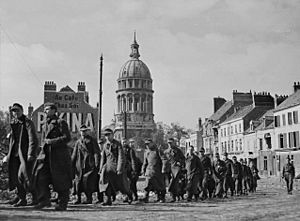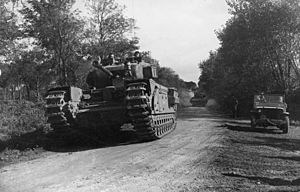Operation Wellhit facts for kids
Quick facts for kids Operation Wellhit (Battle of Boulogne) |
|||||||
|---|---|---|---|---|---|---|---|
| Part of Western Front, in the Second World War | |||||||
 German prisoners marching through Boulogne shortly after its capture, September 22, 1944 |
|||||||
|
|||||||
| Belligerents | |||||||
| Commanders and leaders | |||||||
| Strength | |||||||
| 2 infantry brigades supporting armour, artillery and aircraft |
10,000 | ||||||
| Casualties and losses | |||||||
| 600 killed or wounded | c. 500 killed or wounded 9,500 captured |
||||||
Operation Wellhit, also known as the Battle of Boulogne, was an important military operation during the Second World War. It took place from September 17 to 22, 1944. The main goal was for the 3rd Canadian Division of the First Canadian Army to capture the heavily fortified port city of Boulogne in northern France.
The Canadian troops had hoped to take Boulogne quickly as they moved along the coast. However, strong German defenses about 5 miles (8 km) from the city stopped their advance. Even though Boulogne's defenses were not fully finished, they were still very strong. This meant the Allies had to use huge bombardments from planes and artillery. They also used special tanks called Hobart's Funnies.
The bombings did not destroy as much as expected. But the close teamwork between artillery, air force, tanks, and infantry helped the operation succeed.
Contents
Why Boulogne Was Important
Boulogne: A German Fortress
Adolf Hitler had declared Boulogne and other Channel ports as "fortresses." This meant they were supposed to be heavily defended. The soldiers inside were ordered to fight until the very end. The idea was to stop the Allies from using these important ports. It also forced the Allies to keep many troops busy just holding these areas.
However, Boulogne's defenses on the land side were not complete. Many of the German soldiers were not the best quality. They were also losing hope because they felt cut off. Their commander, Ferdinand Heim, knew the situation was bad. None of the strongpoints fought to the very end. They chose to surrender when faced with powerful Allied forces.
The City's Location
Boulogne is a city and port located where the River Liane meets the sea. The river divides the city. The western side is on a high peninsula, about 250 feet (76 meters) tall. High ground surrounds the city, with important hills that had been fortified over many years. Key strongpoints were at La Tresorerie, Mont Lambert, and Herquelingue.
Commander Heim had only recently taken charge. While the defenses along the coast were strong, not much had been done on the land side. He was ordered to create a strong defensive zone. But he did not have the right equipment or enough resources to do this.
Allied Need for Ports
The Allied forces were advancing into Germany. They desperately needed supplies to reach the front lines. The lack of nearby ports made this very difficult. Boulogne was a vital port for supplies. The Canadian Army commander, Harry Crerar, knew that a full, planned attack would be needed. This attack would require heavy bombings from land, air, and sea. It would also need special tanks. He wanted to be sure of success. This would help keep up the momentum after capturing Le Havre. It would also put pressure on other German fortresses like Calais and Dunkirk.
Getting Ready for the Battle
Allied Preparations
Getting ready for Operation Wellhit was tough. It was hard to move artillery ammunition from Normandy and Dieppe. Also, the siege of Le Havre had to finish first. This was so tanks and artillery could become available for Boulogne. The Canadians got useful information about German defenses. They learned from civilians who had been forced to leave the city. The local French Resistance also helped a lot.
The Allies tried to weaken German defenses with air and artillery bombings. There was also a huge bombing for the last 90 minutes before the attack. Hundreds of bombers were used. However, these bombings were surprisingly not very effective. Commander Heim said that his soldiers had "almost negligible" casualties. He also said that permanent buildings suffered little damage. Bomb craters actually made it harder for tanks to support the infantry attacks. Still, Canadian reports noted that progress was much faster in the bombed areas. This was because the bombings affected the German defenders.
The Canadian Plan
The Canadian plan was to attack Boulogne from the east. The defenses to the north and south would be held back or distracted. German artillery at La Tresorerie was a threat. So, the North Shore Regiment would attack there earlier than the main assault.
In the main attack, two infantry brigades would move forward. They would advance along the main road from La Capelle. The 8th Canadian Infantry Brigade would be north of the road. The 9th Canadian Infantry Brigade would be south of it. Once the main city area was captured, the 8th Brigade would clear areas like Wimille and Wimereux. The 9th Brigade would clear the Outreau peninsula.
The Attack Begins
September 17: First Day
The main attacks went well. Infantry soldiers were carried in Kangaroo armored personnel carriers. The 8th Brigade captured Rupembert and its radar station. They then moved to Marlborough, about 1 mile (1.6 km) northwest of the city center.
Mont Lambert was seen as the key to Boulogne's defense by both sides. The 9th Brigade's early advance was fast. But once the German defenders recovered from the bombings, they fought back strongly. They used artillery and machine guns. However, once paths were cleared through minefields, special tanks arrived. These included Armoured Vehicle Royal Engineers (AVREs) and Churchill Crocodile flame-throwing tanks. The tanks of the Fort Garry Horse also provided support. By nightfall, much of Mont Lambert was under Canadian control. La Tresorerie was harder to take than expected. But its artillery did not interfere with the main attacks.
September 18: Pushing Forward
The guns at La Tresorerie were captured by the North Shore Regiment. The other two regiments in the 8th Brigade made good progress. They moved through the suburbs and hills north of the city. The 9th Brigade's North Nova Scotias finally took Mont Lambert by 11:00 AM. General Heim believed that losing Mont Lambert meant defending the port was impossible.
The Glengarries, supported by AVREs, pushed past St Martin to the upper town, or citadel. This area is very high above the port. It was surrounded by thick medieval stone walls and a dry ditch. As the Canadians got ready to attack, a French civilian showed them a secret passage. A group of soldiers went under the walls. At the same time, tank fire and explosions at the gates made the German defenders surrender.
A company of North Nova Scotias, with tank support, broke through to the River Liane in the city center. The reserve battalion, the Highland Light Infantry of Canada (HLI), moved to the river. The bridges had been partly destroyed. This stopped an immediate advance to the western side. Later, the HLI stormed across the river under heavy fire. Overnight, one bridge was quickly repaired. By daylight, light vehicles could cross the river.
September 19: Crossing the River
Once across the Liane, the 9th Brigade moved south along the river's west bank. The Glengarries captured the suburb of Outreau. The 9th Brigade faced heavy fire from a strong German position called Buttercup. This position was on top of the peninsula between the river and the sea. Close teamwork between the infantry and a moving wall of artillery fire helped them take this strongpoint.
The Divisional reserve, the Cameron Highlanders of Ottawa, successfully attacked Herquelingue heights. This was southeast of the city, east of the river, during the night of September 18-19. A large group of German soldiers had hidden in tunnels under the fortifications. They had to be dealt with separately on September 20. This was called the "bargain basement incident."
In the northern area, the 8th Brigade's North Shore Regiment moved against Wimille. They also attacked the coastal town of Wimereux. The Queen's Own Rifles of Canada and the Chaudière were responsible for taking the fortress of Fort de la Crèche. This fort was heavily defended by some of General Heim's best troops. To protect Canadian activities elsewhere, a smoke screen was used to hide it.
September 20–21: Final Pushes
The Nova Scotias continued their advance along the river's west bank. They captured St Etienne, which was opposite Herquelingue. They then crossed the peninsula and moved north. Their goal was to deal with the defended coastal areas of Nocquet, Ningles, and Le Portel. The Camerons crossed the Liane and protected the southern side.
In the northern area, Wimille was attacked by the 8th Brigade. It was captured the next morning after strong resistance. The North Shore Regiment continued fighting north of Boulogne. They attacked the coastal town of Wimereux, about 3 miles (4.8 km) north of Boulogne. They limited the use of artillery to avoid harming civilians.
Attacks against Fort de la Crèche began with scouting patrols by the Queen's Own Rifles and the Chaudière. They met strong resistance. But an attack by bombers from No 2 Group RAF weakened the defenders. This made them less willing to fight.
September 22: The End of the Battle
The capture of Wimereux was completed. The people living there were very relieved. The tired soldiers defending Fort de la Crèche surrendered to the Queen's Own Rifles. This happened after a short fight and bombing before 8:00 AM. The northern parts of Boulogne were now held by the Canadians.
The last strong resistance was at two fortresses at Le Portel on the Outreau peninsula. An ultimatum (a final demand) was given over loudspeakers. The soldiers in the northern fort marched out to surrender to the HLI just before the deadline. This left only the southern fort, where General Heim was located. It continued firing. Tanks, including flame-throwers, were brought forward. The German soldiers destroyed their guns. A cease-fire (stop fighting) began at 4:17 PM. At 4:30 PM, Heim was reported captured and on his way to brigade headquarters. A single gun on the harbor wall kept firing until Heim ordered it to stop.
German Surrender
The German surrender was accepted by Canadian Brigadier John Meredith Rockingham.
After the Battle
Once the fighting stopped, civilians returned to their homes. The city quickly began to recover. Canadian Civil Aid units helped the civilians. They provided soup kitchens, water, and medical aid.
The port of Boulogne had to be cleared of wreckage, sunken ships, and mines before it could be used. The 8th and 9th Canadian Brigades were moved to Calais and the German heavy batteries at Cap Gris Nez. An Army group specializing in port repair arrived to clear the harbor.
On October 10, an Operation Pluto oil pipeline was laid from Dungeness in England. But the harbor was not open for ships until October 14. The Allies urgently needed Boulogne's added capacity. Even though the larger port of Antwerp had been captured, it could not be used until its approaches were cleared. This happened during the Battle of the Scheldt, which ended on November 8. Mine-clearing in the Scheldt was finished on November 28.


